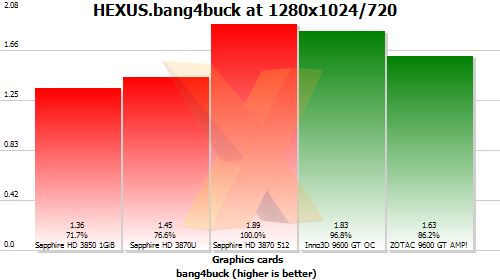HEXUS.bang4buck, and overclocking
HEXUS.bang4buck
In a rough-and-ready assessment of the cards' bang per buck, we've aggregated the 1,280x1,024/720 frame-rates for the three games, normalised them* and taken account of listed the cards' prices.
But there are more provisos than we'd care to shake a stick at. We could have chosen three different games, the cards' prices could have been derived from other sources and pricing tends to fluctuate daily.
Consequently, the table and graph below highlight a metric that should
only be used as a yardstick for evaluating comparative performance with
price factored in. Other architectural benefits are not covered,
obviously.
| Graphics cards | Sapphire Radeon HD 3850 1GiB | Sapphire Radeon HD 3870 ULTIMATE 512MiB | Sapphire Radeon HD 3870 512MiB | Inno3D GeForce 9600 GT Overclock 512MiB | ZOTAC GeForce 9600 GT AMP Edition 512MiB |
|---|---|---|---|---|---|
| Actual aggregate marks at 1,280x1,024/720 | 191.19 | 208.27 | 210.94 | 230.33 | 237.53 |
| Aggregate marks, normalised*, at 1,280x1,024/720 | 162.68 | 173.84 | 175.96 | 190.51 | 195.73 |
| Current price | £120 | £120 | £93 | £104 | £120 |
| HEXUS.bang4buck score at 1,280x1,024/720 | 1.356 | 1.449 | 1.892 | 1.832 | 1.631 |
| Acceptable frame rate (av. 60fps) at 1,280x1,024/720 | No (CoH DX10) | No (CoH DX10) | No (CoH DX10) | No (CoH DX10) | No (CoH DX10) |
* The normalisation refers to taking playable frame rate into account. Should a card benchmark at over 60 frames per second in any one game, the extra fps count as half. Similarly, should a card benchmark lower, say at 40fps, we deduct half the difference from its average frame rate and the desired 60fps, giving it a bang4buck score of 30 marks. The minimum allowable frame rate is 20fps but that scores zero.
As an example, should a card score 120fps we treat it as 90fps as only half the frame rate above 60fps is counted for the bang4buck - this is the formula: (120-((120-60)/2)). Similarly, should it score 30fps, we count it as only 15fps: (30+((30-60)/2)).
The reasoning behind such calculation lies with playable frame rates.
Should card A score 110fps in a benchmark and card B 160, then card B would otherwise receive an extra 50 marks in our bang4buck assessment, even though both cards produce perfectly playable frame rates and anything above 60fps is a bonus and not a necessity for most.
Similarly, without our adjustments, the aggregated bang4buck total for two very different cards would be identical if, in a further benchmark, card A scored a smooth 70fps and card B an unplayable 20fps. Both would win marks totally 180, yet the games-playing experience would be vastly different.
A more realistic (and useful) assessment would say that card A is better because it ran smoothly in both games - and that view would be accurately reflected in our adjusted aggregation, where card A would receive 150 marks (85+65) and card B 100 (100+0).
In effect, we're including a desired average frame rate, in this case 60, and penalising lower performance while giving frame rates higher than 60fps only half as much credit as those up to 60fps. If this doesn't make sense or you have issue with it, please hit the HEXUS community.
Here's the HEXUS.bang4buck graph at 1,280x1,024/720.

The graph divides the normalised score by the price.
The Sapphire Radeon HD 3850 1GiB's lacklustre performance and relatively high price keeps its HEXUS.bang4buck score down. The HD 3870 ULTIMATE fares a little better, being based on a faster architecture, but it's still some way behind a regular card, due to its extremely aggressive pricing. That, though, misses the ULTIMATE's zero-noise cooling point. Both GeForce 9600 GT cards do well, we note.
Temperature musings
| Graphics cards | Sapphire Radeon HD 3850 1GiB | Sapphire Radeon HD 3870 ULTIMATE 512MiB | Inno3D GeForce 9600 GT OC 512MiB | ZOTAC GeForce 9600 GT AMP! |
|---|---|---|---|---|
| Ambient temperature | 22°C | 22.5°C | 19.5°C | 19°C |
| Idle temperature | 41°C | 46°C | 39°C | 41°C |
| Load temperature | 66°C | 70°C | 61°C | 63°C |
| Ambient-to-load delta | 44°C | 47.5°C | 41.5°C | 44°C |
A 120mm fan was blowing over each card in our test-rig. Taking that into account, the ULTIMATE's load temperature, whilst below threshold, could rise significantly further in a chassis without decent ventilation. Users really need to take good airflow into account when deliberating on whether to purchase a high-spec. passively-cooled card.
Overclocking.
The HD 3850 1GiB native clocking of 702/1,656MHz scaled to an
impressive 816/1,916MHz with some basic overclocking; the
GDDR3
memory proving to be particularly effective. That still makes it
somewhat slower than an HD 3870's 777/2,252MHz base clocks, though.The HD 3870 ULTIMATE scaled up from 777/2,252MHz to 855/2,332MHz. Re-running Enemy Territory: Quake Wars at 1,280x1,024, the HD 3850 1GiB's performance increased from an average of 50.93fps to 58fps, whilst the ULTIMATE's ran from 56.1fps to 59.83fps, matching the Inno3D GeForce 9600 GT OC's.
We reckon the 3850's 1GiB framebuffer is somewhat helping out here, as its overclocked frequencies are somewhat lower but the performance is very similar to the ULTIMATE's.









